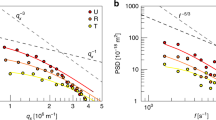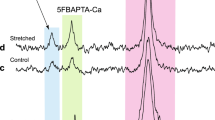Abstract
It has long been suspected that the erythrocytes of patients with sickle cell disease gradually shed part of their plasma membrane either through a normal ageing process or as a result of repeated sickling, and that this membrane loss may be associated with the formation of irreversibly sickled cells1–3. We report here that when sickled HbS erythrocytes are unsickled by reoxygenation, the cells lose ∼2–3% of their lipid as spectrin-free haeomoglobin-containing spicules in the form of rods and microspheres. The rods, which still contain polymerized haemoglobin, eventually degrade to chains of microvesicles having diameters of ∼0.1 µm. Similar spicular material has been found in the untreated blood of patients with sickle cell disease.
This is a preview of subscription content, access via your institution
Access options
Subscribe to this journal
Receive 51 print issues and online access
$199.00 per year
only $3.90 per issue
Buy this article
- Purchase on Springer Link
- Instant access to full article PDF
Prices may be subject to local taxes which are calculated during checkout
Similar content being viewed by others
References
Bessis, M. D., Bricka, E. E., Breton-Gorius, J. & Tabius, J. Blood 9, 39–45 (1954).
Padilla, F., Bromberg, P. A. & Jensen, W. N. Blood 41, 653–660 (1973).
Allan, D., Limbrick, A. R., Thomas, P. & Westerman, M. P. Br. J. Haemat. 47, 383–390 (1981).
Maugh, T. H. Science 211, 265–267 (1981).
Rumsby, R. H., Trotter, J., Allan, D. & Michell, R. H. Biochem. Soc. Trans. 5, 126–127 (1977).
Lutz, H. V. J. supramolec. Struct. 8, 375–389 (1978).
Allan, D., Billah, M. M., Finean, J. B. & Michell, R. H. Nature 261, 58–60 (1976).
Shukla, S. D., Berriman, J., Coleman, R., Finean, J. B. & Michell, R. H. FEBS Lett. 90, 289–291 (1978).
Allan, D., Thomas, P. & Limbrick, A. R. Biochem. J. 188, 881–887 (1980).
Lessin, L. S., Kurantsin-Mills, J., Wallas, C. & Weems, H. J. supramolec. Struct. 9, 537–554 (1978).
Shaklai, N., Sharma, V. S. & Ranney, H. M. Proc. natn. Acad. Sci. U.S.A. 78, 65–68 (1981).
Chui, D., Lubin, B., Roelofsen, B. & van Deenen, L. L. M. Blood 58, 398–401 (1981).
Westerman, M. P., Diloy-Puray, M. & Streczyn, M. Biochim. biophys. Acta 557, 149–155 (1979).
Bertles, J. F. & Döbler, J. Blood 33, 884–898 (1969).
Laemmli, U. K. Nature 277, 680–685 (1970).
Steck, T. L. J. Cell Biol. 62, 1–19 (1974).
Author information
Authors and Affiliations
Rights and permissions
About this article
Cite this article
Allan, D., Limbrick, A., Thomas, P. et al. Release of spectrin-free spicules on reoxygenation of sickled erythrocytes. Nature 295, 612–613 (1982). https://doi.org/10.1038/295612a0
Received:
Accepted:
Issue Date:
DOI: https://doi.org/10.1038/295612a0
This article is cited by
-
Large red cell-derived membrane particles are major contributors to hypercoagulability in sickle cell disease
Scientific Reports (2021)
-
Faster Sickling Kinetics and Sickle Cell Shape Evolution during Repeated Deoxygenation and Oxygenation Cycles
Experimental Mechanics (2019)
-
Red blood cell complement receptor one level varies with Knops blood group, α+thalassaemia and age among Kenyan children
Genes & Immunity (2016)
-
Selection of urinary sediment miRNAs as specific biomarkers of IgA nephropathy
Scientific Reports (2016)
-
Impact of circulating erythrocyte-derived microparticles on coagulation activation in sickle cell disease
Comparative Clinical Pathology (2015)
Comments
By submitting a comment you agree to abide by our Terms and Community Guidelines. If you find something abusive or that does not comply with our terms or guidelines please flag it as inappropriate.



